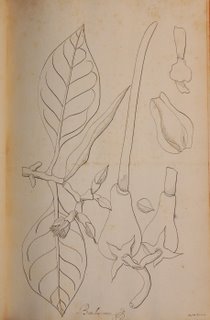josef george kamel, s.j. drawing of bakawan or mangrove

Bakawan is a generic name for mangrove. There are a number of trees called bakawan namely Rhizopora apiculata Bl. (bakawan or bakaw), R. mucronata Lmk (bakawan-babaye), R. stylosa (bakawan-bato). Of these the mucronata and the apiculata are used for reforestation of mangroves but they are also the most exploited too because their wood is made into charcoal. Because of frequent cutting, the trees, which can reach a height of 30 to 35 meters, remain stunted as shrubs less than three meters.
Typical of mangrove, the bakawan grows on muddy estuaries, seashores, swamps and tidal flats. Bakawan shoots out vertical roots or pneumatophores from the principal roots sunk deep in the soft gray mud and sand where it grows. These porous roots allow gas exchange between the tree and the atmosphere. Bakawan survives well in waters differing in saltiness.
Kamel has drawn the bakawan seed accurately. The seeds dangle from branches on green stalks at the bottom of which is a brown pear-shaped structure. When mature the stalk and all fall to the muddy and sandy soil, and the bakawan begins life straight and properly planted.
The exploitation of bakawan and the clear cutting of bakawan growing in swamps to make ponds for the commercial cultivation of fish and prawns have aversely affected the environment of many coastal areas in the Philippines. The bakawan forest, now recognized as important as the tropical rain forest, serves a buffer for typhoons and storm surges just as the tropical rain forests softens the impact of the monsoon rains. Many of the species of fish used as food are born under the shelter of the bakawan trees. Many species of fish spawn annually at brackish estuaries and when the fish hatch the fries swim to the sea where they spend life until adulthood. The bakawan is also home to numerous species of crustaceans, like the crab and shrimp, and to varieties of mollusks like the oyster. Like the rain forest, the mangrove forest is the nursery and home of many species. Like the rain forest, the mangrove forest purifies the air.
Save the mangrove forest and protect the food chain. Save the mangrove forest and preserve the quality of life.

0 Comments:
Post a Comment
<< Home